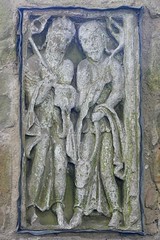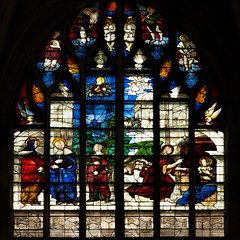Index of all all
 These 2nd and 3rd century Roman sarcophagi in the Camposanto, Pisa, were the inspiration for the beginning of the Italian Renaissance sculpture of the 13th century. In particular the Phaedra Sarcophagus, pictured above, was the model for Nicola Pisano's Madonna, and animal scenes on the pulpit in the cathedral.
These 2nd and 3rd century Roman sarcophagi in the Camposanto, Pisa, were the inspiration for the beginning of the Italian Renaissance sculpture of the 13th century. In particular the Phaedra Sarcophagus, pictured above, was the model for Nicola Pisano's Madonna, and animal scenes on the pulpit in the cathedral.
 Ango Saxon sculpture is divided into two main periods, that before the 9th century Danish invasion and that after King Alfred (871-899). The period covers a period from the earliest Christian crosses, and includes stone decorative elements in churches depicting grotesque animals and fiugures intertwined with vine tendrils.
Ango Saxon sculpture is divided into two main periods, that before the 9th century Danish invasion and that after King Alfred (871-899). The period covers a period from the earliest Christian crosses, and includes stone decorative elements in churches depicting grotesque animals and fiugures intertwined with vine tendrils.
Striking animal reliefs, carved around 800 CE, are among the finest surviving examples of Anglo-Saxon sculpture from the Mercian kingdom. They were originally part of the 9th-century monastery at Breedon-on-the-Hill and are now set into the walls of the later Augustinian priory church of St Mary and St Hardulph.
 This relief belongs to the important group of Anglo-Saxon sculptures from Breedon-on-the-Hill, dating from the late eighth or early ninth century. Carved in local sandstone and set within a rectangular frame, it depicts two standing male figures rendered in high relief beneath an architectural arch. Both figures are shown in long, pleated garments and hold leaf-topped rods in their right hands, a detail that identifies them not as craftsmen or labourers, but as prophets or inspired teachers.
This relief belongs to the important group of Anglo-Saxon sculptures from Breedon-on-the-Hill, dating from the late eighth or early ninth century. Carved in local sandstone and set within a rectangular frame, it depicts two standing male figures rendered in high relief beneath an architectural arch. Both figures are shown in long, pleated garments and hold leaf-topped rods in their right hands, a detail that identifies them not as craftsmen or labourers, but as prophets or inspired teachers.
Romanesque is a term given to architecture and art from 1000 AD until about 1150 AD when it was succeeded by the Gothic. The term Romanesque was first used by the French antiquarian Charles-Alexis-Adrien de Gerville in a letter to Auguste Le Prévost (1818).






